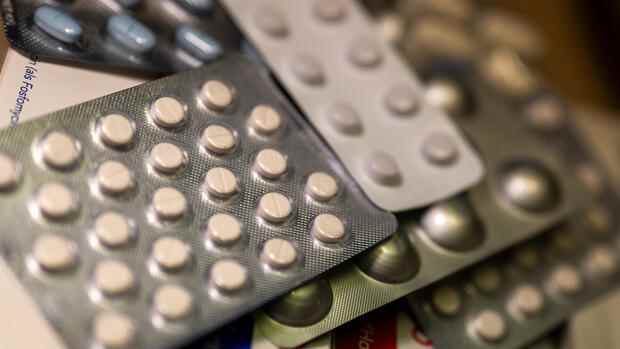Frankfurt The industry association Pro Generika fears that manufacturers of imitation drugs (generics) will have to withdraw from the production of more and more drugs in the future because it is no longer economical. The reason for this is the sharply rising costs for energy, raw materials and transport as well as inflation.
Providers of generics are particularly affected by this, as drug prices are fixed. The industry cannot simply pass on price increases to customers. In addition, calculations are tight in the generics industry and margins are generally low.
“Inflation worries everyone, but we can’t even begin to pass on the increased manufacturing costs,” says Peter Stenico, CEO of Sandoz Germany. In Tyrol, the company operates the last major production facility for penicillin in Europe. According to the industry association, almost all antibiotics now come from Asia. Stenico expects energy costs in the production of antibiotics to increase by around tenfold in the coming year. “It would already be cheaper for us to buy the product in China than to produce it ourselves,” says the Sandoz manager.
Josip Mestrovic, head of Germany at the generics manufacturer Zentiva, also reports that costs have risen sharply: 200 percent for energy, 50 to 160 percent for raw materials and 500 percent for transport costs. In Germany alone, Zentiva had to shoulder twelve million euros in additional costs, and that with prices remaining the same, according to Mestrovic.
Top jobs of the day
Find the best jobs now and
be notified by email.
Pro generics is therefore calling on politicians to defuse the situation as quickly as possible. Association Managing Director Bork Bretthauer: “If the manufacturers make losses, they get out of production. We saw what that leads to from the bottlenecks in the cancer drug tamoxifen and in fever juice.” Politicians must now ensure that prices can rise with the costs – otherwise there would be further bottlenecks, according to Bretthauer.
Six cents a dose for the manufacturers
Specifically, the generics industry is demanding inflation compensation during the year for the price-capped drugs. Regulations are to be included in the rebate agreements concluded with the health insurance funds, which will enable drug prices to be adjusted to the new, extreme inflation.
>> Read also: Billion IPO planned – Novartis wants to spin off generics division Sandoz
The generics industry has been under pressure on margins for years. In particular, the discount contracts of the statutory health insurance companies, which started in 2007, have pushed prices down massively. In most cases, the bidder with the lowest bid is awarded the contract.
The share of inexpensive generics in the pharmaceutical supply has risen continuously over the past ten years from 70 to 79 percent (2021). Of the 33 billion euros in drug costs for statutory health insurance, after deducting the discounts from discount agreements, two billion euros still went to the generic drug manufacturers.
This corresponds to 7.2 percent of drug expenditure. According to market data from the industry, statutory health insurance companies paid manufacturers an average of 16 cents per daily therapy dose last year. The association calculates that after deducting the legal discounts and the deductions from the discount agreements, the manufacturer still effectively has six cents.
Supply bottlenecks in fever juice and cancer drug
As a result of the lower price level, more and more manufacturers or suppliers have withdrawn from production, and only a few manufacturers are still responsible for the supply. In the case of frequently prescribed drugs such as metformin for diabetes or the cholesterol-lowering drug simvastatin, three manufacturers supply more than 90 percent of the drugs required. If one manufacturer fails in this constellation, the others cannot simply step in and ramp up production. Because that takes a long time.
Box office hit
1.36
euros per bottle
manufacturers of paracetamol-containing fever juices receive from the statutory health insurance companies. The price has been at the same level for ten years.
There was a supply bottleneck for the breast cancer drug tamoxifen at the beginning of the year because several suppliers, from whom a large part of the manufacturers purchased goods, withdrew from production. Those generics suppliers who had other suppliers under contract were able to bridge the shortfall for a while, but the stocks were then bought empty.
There was no alternative drug for tamoxifen. The result was a supply bottleneck, which attempts were made to bridge with imports, but also by prescribing and dispensing only individual, small pack sizes. The company Sandoz (Hexal) also started a limited-time special production. Overall, there are currently three suppliers on the market that produce tamoxifen, with Hexal covering more than 80 percent of the market, according to Stenicos. The company receives eight cents for a tablet of tamoxifen.
The bottleneck in fever juices for children arose because the generics manufacturer 1a Pharma, which belongs to the Novartis subsidiary Sandoz, withdrew from the production of paracetamol-containing juices for children from May for reasons of economy. The manufacturer Teva/Ratiopharm, as the last remaining main supplier on the market, had to take on the brunt of the supply.
“We now have a market share of 100 percent for fever juices containing paracetamol. But even before that we were producing at a loss,” says Andreas Burkhardt, General Manager of Teva Germany and Austria, describing the situation. Because of the fixed amount negotiated with the statutory health insurance companies, the price for the juice has been at the same level for ten years: According to Pro Generika, the manufacturer receives 1.36 euros per bottle. The prices for energy, logistics and active ingredients that had risen during this period could not be passed on. Now the new cost increases are added.
More: Manufacturers only get 1.36 euros per bottle: fever juice for children is becoming scarce
